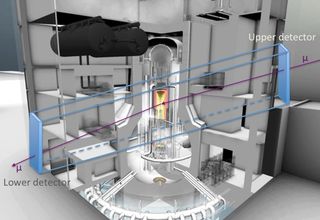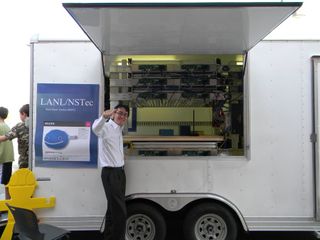Cosmic Rays May Reveal Damage to Fukushima's Nuclear Reactors

Radiation is still leaking from the Fukushima Daiichi nuclear plant after the 2011 tsunami-related meltdown in Japan, making any damage assessment dangerous for both humans and machines. Instead, high-energy particles created by cosmic rays striking the Earth's atmosphere could provide an X-ray-style image of the damage from a much safer distance.
Technology capable of harnessing the high-energy muon particles comes from the Los Alamos National Laboratory (LANL) in New Mexico. Shortly after 9/11, the U.S. lab developed a muon detector that could spot uranium or plutonium nuclear weapons hidden inside cargo containers by tracking the changed paths of ghostly muons as they traveled through the nuclear materials.
Now the Los Alamos team is working with Japanese officials to apply the same idea to look inside the damaged Fukushima plant. [Radioactive Water Leaks from Fukushima: What We Know]
"It sounds pretty outrageous if someone says, 'I can see through that 2 meters of concrete and 8 inches of steel and see the core of the reactors with detectors sitting outside your building,'" said LANL physicist Christopher Morris. "People started off very skeptical."
Ghostly particle images
A muon detector first invented in the 1950s has already allowed scientists to peer inside of volcanoes and Egyptian pyramids; the method looks for changes in the rate of muons passing through structures caused by denser materials stopping some of the particles.
But the LANL technology, called muon scattering radiography, has proven to be better at detecting the differences between materials such as uranium fuel rods and the water inside a nuclear reactor. The scattering technique uses two detectors to measure both the incoming and outgoing paths of muons, so the method can measure the less obvious changes in a muon's direction when the elementary particle encounters certain materials. [Wacky Physics: The Coolest Little Particles in Nature]
Sign up for the Live Science daily newsletter now
Get the world’s most fascinating discoveries delivered straight to your inbox.

"If you want to look at cargo containers for uranium bombs or shielded plutonium, the scattering technique is far superior," Morris told LiveScience. "It's the same for looking at a reactor."
Morris guided development of the scattering technique at Los Alamos to the point where it's now a commercialized technology used by the U.S. Department of Homeland Security. But he credits his former colleague, Haruo Miyadera, with spearheading the effort to apply the muon detector to the case of Fukushima — a scenario detailed in the August issue of the journal AIP Advances.
Peering inside a reactor
Miyadera realized the power of muon scattering radiography to help at the Fukushima plant shortly after the March 11, 2011, earthquake and tsunami left the nuclear plant's reactors spiraling out of control. He and the LANL team first hand-calculated the problem to convince themselves the method could reveal the reactor damage from outside the reactor buildings.
The researchers went on to test their "Muon Mini Tracker" technology on a mock-up of a reactor at LANL, as well as on a working nuclear reactor at the University of New Mexico. Since that time, Miyadera has left the lab to move back to Japan and work with the Toshiba Corporation on possibly deploying a larger version of the technology at the Fukushima site.
"Since the physics used in the muon-scattering method is relatively simple, we are confident with our technique — there will be no scientific surprise," Miyadera said. "In fact, all the challenges are in engineering, not in science."
Such engineering challenges include figuring out where to install the muon detectors near the Fukushima plant, building a shield out of concrete to screen out some of the radiation, and ensuring that workers installing the detectors don't get long periods of radiation exposure.

Helping out Fukushima
Japanese officials have not yet given the idea the green light. But Japan's Tokyo Electric Power Co. (TEPCO) in charge of the Fukushima plant provided funding to fly the Los Alamos National Laboratory team and their equipment out to Japan for some on-site measurements last summer.
Toshiba also recently tested the muon detectors' performance on a research nuclear reactor owned by the company in Kawasaki, Japan. Those results have not yet been published, but the LANL team was confident the tests could help convince Japanese officials about the muon detector method.
The muon detectors could prove especially helpful in figuring out the size and location of building debris in the damaged Fukushima reactor buildings, as well as calculating the amount of nuclear fuel that has melted through the reactor's pressure vessel and fallen into a concrete well below. (TEPCO is currently struggling to contain leaks of radioactive water contaminated by the fuel.)
Japan's government aims to begin removing debris from the site in 2020. Ideally, the muon detectors could help image the reactors over a period of several months between 2015 and 2016, Miyadera said.
The muon detectors could still prove useful for future nuclear reactor emergencies or even routine maintenance checks, even if they don't end up deploying at the Fukushima site, Morris said. He pointed out that nobody has yet died as a direct result of radiation exposure from the Fukushima nuclear plant meltdown, and suggested nuclear power has a role to play in a world that still relies heavily on coal power plants.
"If we can help clean up this reactor and if that helps the reactor industry recover so we stop spewing soot and carbon dioxide into the atmosphere, I will feel very satisfied," Morris said.
You can follow Jeremy Hsu on Twitter @jeremyhsu. Follow us @livescience, Facebook & Google+. Original article on LiveScience.
Most Popular

